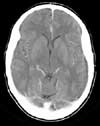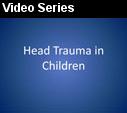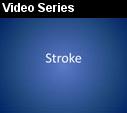Computed Tomography (CT) - Head
- What is CT Scanning of the Head?
- What are some common uses of the procedure?
- How should I prepare?
- What does the equipment look like?
- How does the procedure work?
- How is the procedure performed?
- What will I experience during and after the procedure?
- Who interprets the results and how do I get them?
- What are the benefits vs. risks?
- What are the limitations of CT Scanning of the Head?
What is CT Scanning of the Head?
Computed tomography, more commonly known as a CT or CAT scan, is a diagnostic medical test that, like traditional x-rays, produces multiple images or pictures of the inside of the body.
The cross-sectional images generated during a CT scan can be reformatted in multiple planes, and can even generate three-dimensional images. These images can be viewed on a computer monitor, printed on film or transferred to a CD or DVD.
CT images of internal organs, bones, soft tissue and blood vessels typically provide greater detail than traditional x-rays, particularly of soft tissues and blood vessels.
CT scanning provides more detailed information on head injuries, stroke, brain tumors and other brain diseases than regular radiographs (x-rays).
What are some common uses of the procedure?
CT scanning of the head is typically used to detect:
- bleeding, brain injury and skull fractures in patients with head injuries.
- bleeding caused by a ruptured or leaking aneurysm in a patient with a sudden severe headache.
- a blood clot or bleeding within the brain shortly after a patient exhibits symptoms of a stroke.
- a stroke, especially with a new technique called Perfusion CT.
- brain tumors.
- enlarged brain cavities (ventricles) in patients with hydrocephalus.
- diseases or malformations of the skull.
CT scanning is also performed to:
- evaluate the extent of bone and soft tissue damage in patients with facial trauma, and planning surgical reconstruction.
- diagnose diseases of the temporal bone on the side of the skull, which may be causing hearing problems.
- determine whether inflammation or other changes are present in the paranasal sinuses.
- plan radiation therapy for cancer of the brain or other tissues.
- guide the passage of a needle used to obtain a tissue sample (biopsy) from the brain.
- assess aneurysms or arteriovenous malformations through a technique called CT angiography. For more information, see the CT Angiography page (www.RadiologyInfo.org/en/info.cfm?pg=angioct).
How should I prepare?
You should wear comfortable, loose-fitting clothing to your exam. You may be given a gown to wear during the procedure.
Metal objects, including jewelry, eyeglasses, dentures and hairpins, may affect the CT images and should be left at home or removed prior to your exam. You may also be asked to remove hearing aids and removable dental work. Women will be asked to remove bras containing metal underwire. You may be asked to remove any piercings, if possible.
You should inform the technologist if you have a pacemaker. Pacemakers do not hinder the use of CT as in MRI as long as the scanner will not be taking images repeatedly over the area of the pacemaker device in the upper chest. This is usually not an issue for cardiac CT exams.
You may be asked not to eat or drink anything for a few hours beforehand, especially if a contrast material will be used in your exam. You should inform your physician of all medications you are taking and if you have any allergies. If you have a known allergy to contrast material, or "dye," your doctor may prescribe medications (usually a steroid) to reduce the risk of an allergic reaction. These medications generally need to be taken 12 hours prior to administration of contrast material. To avoid unnecessary delays, contact your doctor before the exact time of your exam.
Also inform your doctor of any recent illnesses or other medical conditions and whether you have a history of heart disease, asthma, diabetes, kidney disease or thyroid problems. Any of these conditions may increase the risk of an unusual adverse effect.
The radiologist also should know if you have asthma, multiple myeloma or any disorder of the heart, kidneys or thyroid gland, or if you have diabetes—particularly if you are taking Glucophage.
Women should always inform their physician and the CT technologist if there is any possibility that they may be pregnant. See the Safety page (www.RadiologyInfo.org/en/safety/) for more information about pregnancy and x-rays.
What does the equipment look like?
The CT scanner is typically a large, box-like machine with a hole, or short tunnel, in the center. You will lie on a narrow examination table that slides into and out of this tunnel. Rotating around you, the x-ray tube and electronic x-ray detectors are located opposite each other in a ring, called a gantry. The computer workstation that processes the imaging information is located in a separate control room, where the technologist operates the scanner and monitors your examination in direct visual contact and usually with the ability to hear and talk to you with the use of a speaker and microphone.
How does the procedure work?
In many ways CT scanning works very much like other x-ray examinations. Different body parts absorb the x-rays in varying degrees. It is this crucial difference in absorption that allows the body parts to be distinguished from one another on an x-ray film or CT electronic image.
In a conventional x-ray exam, a small amount of radiation is aimed at and passes through the part of the body being examined, recording an image on a special electronic image recording plate. Bones appear white on the x-ray; soft tissue, such as organs like the heart or liver, shows up in shades of gray, and air appears black.
With CT scanning, numerous x-ray beams and a set of electronic x-ray detectors rotate around you, measuring the amount of radiation being absorbed throughout your body. Sometimes, the examination table will move during the scan, so that the x-ray beam follows a spiral path. A special computer program processes this large volume of data to create two-dimensional cross-sectional images of your body, which are then displayed on a monitor. CT imaging is sometimes compared to looking into a loaf of bread by cutting the loaf into thin slices. When the image slices are reassembled by computer software, the result is a very detailed multidimensional view of the body's interior.
Refinements in detector technology allow new CT scanners to obtain multiple slices in a single rotation. These scanners, called multislice CT or multidetector CT, allow thinner slices to be obtained in a shorter period of time, resulting in more detail and additional view capabilities.
 Modern CT scanners are so fast that they can scan through large sections of the body in just a few seconds, and even faster in small children. Such speed is beneficial for all patients but especially children, the elderly and critically ill, all of whom may have difficulty in remaining still, even for the brief time necessary to obtain images.
Modern CT scanners are so fast that they can scan through large sections of the body in just a few seconds, and even faster in small children. Such speed is beneficial for all patients but especially children, the elderly and critically ill, all of whom may have difficulty in remaining still, even for the brief time necessary to obtain images.
 For children, the CT scanner technique will be adjusted to their size and the area of interest to reduce the radiation dose.
For children, the CT scanner technique will be adjusted to their size and the area of interest to reduce the radiation dose.
For some CT exams, a contrast material is used to enhance visibility in the area of the body being studied.
How is the procedure performed?
The technologist begins by positioning you on the CT examination table, usually lying flat on your back or less commonly, on your side or on your stomach. Straps and pillows may be used to help you maintain the correct position and to help you remain still during the exam. Depending on the part of the body being scanned, you may be asked to raise your arms over your head.
 Many scanners are fast enough that children can be scanned without sedation. In special cases, sedation may be needed for children who cannot hold still. Motion will degrade the quality of the examination the same way that it affects photographs.
Many scanners are fast enough that children can be scanned without sedation. In special cases, sedation may be needed for children who cannot hold still. Motion will degrade the quality of the examination the same way that it affects photographs.
If contrast material is used, depending on the type of exam, it will be swallowed, injected through an intravenous line (IV) or administered by enema (this is rare).
Next, the table will move quickly through the scanner to determine the correct starting position for the scans. Then, the table will move slowly through the machine as the actual CT scanning is performed. Depending on the type of CT scan, the machine may make several passes.
You may be asked to hold your breath during the scanning. Any motion, whether breathing or body movements, can lead to artifacts on the images. This loss of image quality can resemble the blurring seen on a photograph taken of a moving object.
When the examination is completed, you will be asked to wait until the technologist verifies that the images are of high enough quality for accurate interpretation.
A CT scan of the head is usually completed within 10 minutes.
What will I experience during and after the procedure?
CT exams are generally painless, fast and easy. With multidetector CT, the amount of time that the patient needs to lie still is reduced.
Though the scanning itself causes no pain, there may be some discomfort from having to remain still for several minutes. If you have a hard time staying still, are claustrophobic or have chronic pain, you may find a CT exam to be stressful. The technologist or nurse, under the direction of a physician, may offer you some medication to help you tolerate the CT scanning procedure.
If an intravenous contrast material is used, you will feel a pin prick when the needle is inserted into your vein. You will likely have a warm, flushed sensation during the injection of the contrast materials and a metallic taste in your mouth that lasts for at most a minute or two. You may experience a sensation like you have to urinate; however, this is actually a contrast effect and subsides quickly.
When you enter the CT scanner room, special light lines may be seen projected onto your body, and are used to ensure that you are properly positioned. With modern CT scanners, you will hear only slight buzzing, clicking and whirring sounds as the CT scanner revolves around you during the imaging process.
You will be alone in the exam room during the CT scan, unless there are special circumstances. For example, sometimes a parent wearing a lead shield may stay in the room with their child. However, the technologist will always be able to see, hear and speak with you through a built-in intercom system.
With pediatric patients, a parent may be allowed in the room but will be required to wear a lead apron to minimize radiation exposure.
After a CT exam, you can return to your normal activities. If you received contrast material, you may be given special instructions.
Who interprets the results and how do I get them?
A physician, usually a radiologist with expertise in supervising and interpreting radiology examinations, will analyze the images and send a signed report to your primary care physician or physician who referred you for the exam, who will discuss the results with you.
Follow-up examinations may be necessary, and your doctor will explain the exact reason why another exam is requested. Sometimes a follow-up exam is done because a suspicious or questionable finding needs clarification with additional views or a special imaging technique. A follow-up examination may also be necessary so that any change in a known abnormality can be monitored over time. Follow-up examinations are sometimes the best way to see if treatment is working or if an abnormality is stable over time.
What are the benefits vs. risks?
Benefits
- CT scanning is painless, noninvasive and accurate.
- A major advantage of CT is its ability to image bone, soft tissue and blood vessels all at the same time.
- Unlike conventional x-rays, CT scanning provides very detailed images of many types of tissue as well as the lungs, bones, and blood vessels.
- CT examinations are fast and simple; in emergency cases, they can reveal internal injuries and bleeding quickly enough to help save lives.
- CT has been shown to be a cost-effective imaging tool for a wide range of clinical problems.
- CT examinations are fast and simple; in emergency cases, they can reveal internal injuries and bleeding quickly enough to help save lives.
- CT has been shown to be a cost-effective imaging tool for a wide range of clinical problems.
- CT is less sensitive to patient movement than MRI.
- CT can be performed if you have an implanted medical device of any kind, unlike MRI.
- A diagnosis determined by CT scanning may eliminate the need for exploratory surgery and surgical biopsy.
- No radiation remains in a patient's body after a CT examination.
- X-rays used in CT scans should have no immediate side effects.
Risks
- There is always a slight chance of cancer from excessive exposure to radiation. However, the benefit of an accurate diagnosis far outweighs the risk.
- The effective radiation dose for this procedure varies. See the Safety page (www.RadiologyInfo.org/en/safety/) for more information about radiation dose.
- Women should always inform their physician and x-ray or CT technologist if there is any possibility that they are pregnant. See the Safety page (www.RadiologyInfo.org/en/safety/) for more information about pregnancy and x-rays.
- CT scanning is, in general, not recommended for pregnant women unless medically necessary because of potential risk to the baby. This risk is, however, minimal with head CT scanning.
- Manufacturers of intravenous contrast indicate mothers should not breastfeed their babies for 24-48 hours after contrast medium is given. However, both the American College of Radiology (ACR) and the European Society of Urogenital Radiology note that the available data suggest that it is safe to continue breastfeeding after receiving intravenous contrast. For further information please consult the ACR Manual on Contrast Media and its references. (www.acr.org/Quality-Safety/Resources/Contrast-Manual)
- The risk of serious allergic reaction to contrast materials that contain iodine is extremely rare, and radiology departments are well-equipped to deal with them.

- Because children are more sensitive to radiation, they should have a CT exam only if it is essential for making a diagnosis and should not have repeated CT exams unless absolutely necessary. CT scans in children should always be done with low-dose technique.
What are the limitations of CT Scanning of the Head?
A person who is very large may not fit into the opening of a conventional CT scanner or may be over the weight limit—usually 450 pounds—for the moving table.
Compared to MR imaging, the precise details of soft tissue (particularly the brain, including the disease processes) are less visible on CT scans. CT is not sensitive in detecting inflammation of the meninges—the membranes covering the brain.
Additional Information and Resources
RadiologyInfo
Brain Tumors
(www.RadiologyInfo.org/en/info.cfm?pg=thera-brain)
Head and Neck Cancer
(www.RadiologyInfo.org/en/info.cfm?pg=hdneck)
RTAnswers.org
Radiation Therapy for Brain Tumors
(www.rtanswers.com/treatmentinformation/cancertypes/brain/index.aspx)
Radiation Therapy for Head and Neck Cancer
(www.rtanswers.com/treatmentinformation/cancertypes/headneck/index.aspx)
Others
American Stroke Association
(www.strokeassociation.org)
National Stroke Association
(www.stroke.org)
Locate an ACR-accredited provider: To locate a medical imaging or radiation oncology provider in your community, you can search the ACR-accredited facilities database.
This website does not provide costs for exams. The costs for specific medical imaging tests and treatments vary widely across geographic regions. Many—but not all—imaging procedures are covered by insurance. Discuss the fees associated with your medical imaging procedure with your doctor and/or the medical facility staff to get a better understanding of the portions covered by insurance and the possible charges that you will incur.
Web page review process: This Web page is reviewed regularly by a physician with expertise in the medical area presented and is further reviewed by committees from the American College of Radiology (ACR) and the Radiological Society of North America (RSNA), comprising physicians with expertise in several radiologic areas.
Outside links: For the convenience of our users, RadiologyInfo.org provides links to relevant websites. RadiologyInfo.org, ACR and RSNA are not responsible for the content contained on the web pages found at these links.
Images: Images are shown for illustrative purposes. Do not attempt to draw conclusions or make diagnoses by comparing these images to other medical images, particularly your own. Only qualified physicians should interpret images; the radiologist is the physician expert trained in medical imaging.
This page was reviewed on March 07, 2013






 Pediatric-specific content
Pediatric-specific content 

